Post-War Baseball Cards: The Golden Era (1942-1979)
Following WWII, baseball boomed, and not surprisingly card collecting followed suit. Baseball cards emerged as more than just promotional tools to become standalone collectibles. In the late 40s and 50s, baseball’s popularity, fueled by the debuts of legends like Jackie Robinson, Willie Mays, Mickey Mantle, Hank Aaron, Roberto Clemente, and Sandy Koufax, cemented baseball card collecting’s place in American culture.
Whether you’re a collector or have cards passed down through generations, vintage card auctions are a great way to maximize the value of your items. Get in touch with us today at 301-608-0355 or click the link below to discuss your valued collectibles, and the potential return if you were to consign to auction. Our experts are standing by.
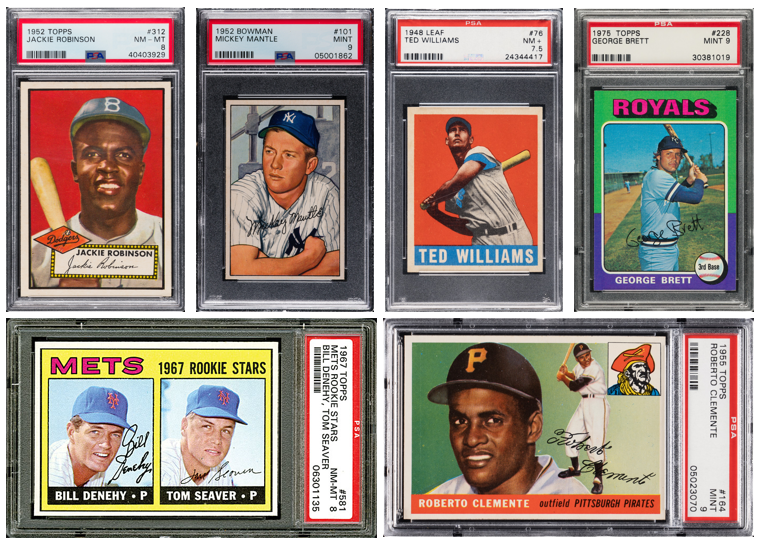
Sample baseball cards spanning the post-war era
The Late 1940s
As baseball’s post-war revival exposed card production as a potentially lucrative industry, Bowman and Leaf emerged as the top brands. One of the most important events in American sports history – the breaking of baseball’s color line in 1947 – is captured in some of the most sought-after cards of the late 1940s.

1948 Leaf Jackie Robinson & Satchel Paige
Jackie Robinson’s major league debut for the Brooklyn Dodgers is recalled with his 1948 Leaf card, which, printed after the 1948 season, includes his accomplishments in his first two years, including being named Rookie of the Year in 1947. Only a few cards were produced honoring Satchel Paige, the legendary black pitcher who followed Robinson into the majors in 1948 at the age of 42. Of those, the Leaf 1948 card is considered the most important. Additionally, the 1948-49 Leaf set included cards for Babe Ruth, Joe DiMaggio, Ted Williams and others top players of the day. Overall, its star power and colorful appearance make it an instantly recognizable and iconic set to collectors.

1948 Leaf Babe Ruth, Joe DiMaggio & Bob Feller
The 1948 Bowman set was light in quantity, only 48 cards, and showed black and white player photos on a textless front. Overall this presentation was uninspiring compared to its Leaf counterpart, but the set predated is notable for producing the first rookie cards for future Hall of Famers like Yogi Berra, Stan Musial, and Warren Spahn.

1948 Bowman Stan Musial & Yogi Berra rookie cards
The 1950s
The 1951 Bowman set published unrivaled and continued to re-establish the popularity of baseball cards thanks in large part to the inclusion of the first rookie cards for Mickey Mantle and Willie Mays. These cards remain today as some of the most sought-after in the hobby. For this set, Bowman stepped up their presentation, with full color illustrations. This simple, yet elegant, presentation would soon be challenged by another company, which would soon become known as the industry’s unquestioned juggernaut.

1951 Bowman Mickey Mantle & Willie Mays rookie cards
Topps entered the market with sets known as Red Backs and Blue Backs, sets of cards that tried to be both baseball cards and playing cards at the same time. When the idea did not pan out as planned Topps went back to the drawing board, and the result was one of the most famous baseball card sets of all time. The 1952 Topps set is most well-known for the “Holy Grail” Mickey Mantle card, but its influence goes further. The cards’ “giant” size, flashy illustrations and expanded player bios would soon become industry standard.
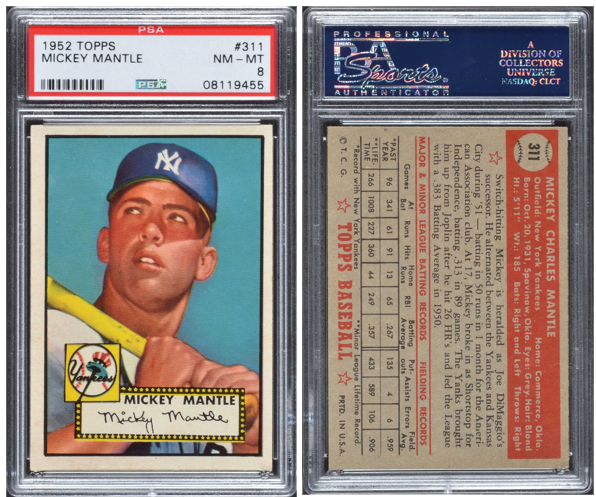
1952 Topps Mickey Mantle
Throughout the early 1950s Topps and Bowman were locked in a legal dispute over who had the rights to produce exclusive cards. Bowman held the rights to Mantle’s image giving them exclusivity in 1954 and 1955, however Topps produced rookie cards for baseball royalty such as Hank Aaron, Ernie Banks, Sandy Koufax, and Roberto Clemente, cementing itself as the industry leader. In 1956 Topps bought out Bowman for $200,000 paving the way for Topps to be the only game in town. Bowman’s 1955 set, which featured players in a television screen frame, was its last until the brand was revived in 1989.
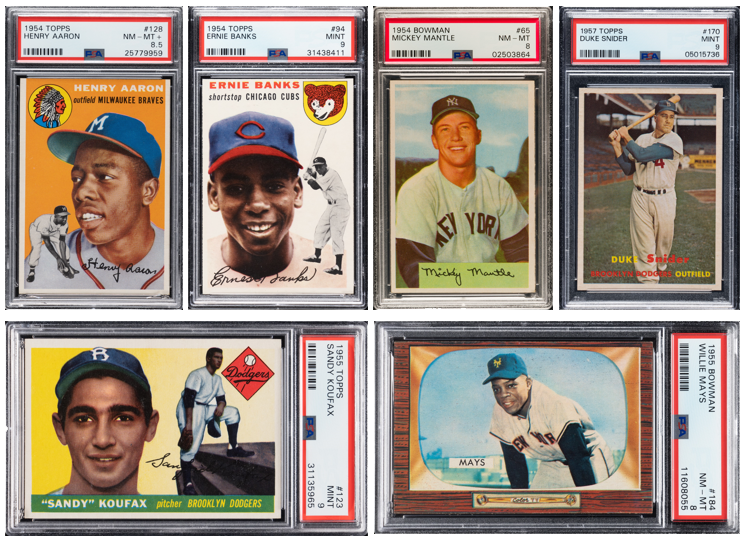
Various 1950s baseball cards
The late 1950s marked the beginning of a new era as the Dodgers and Giants left New York to become the first teams on the West Coast, in Los Angeles and San Francisco. In 1959, Topps released its largest set ever, with 572 graphics-heavy cards including subsets for “Fence Busters” and “Rookie Prospects.” The set contained legends of the day like Mantle, Mays, Clemente, Koufax, Banks, Musial, along with Bob Gibson’s rookie card. The unique card design and innovative set structure put 1959 Topps truly ahead of its time.
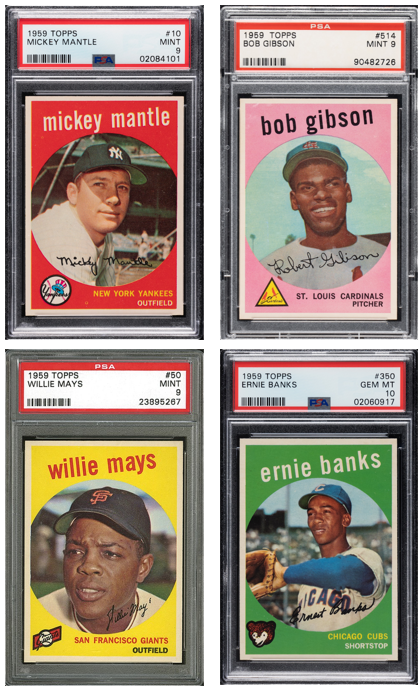
1959 Topps baseball cards
The 1960s and 1970s
By the 1960s card collecting was as popular as ever and Topps maintained control of this growing market. They continued to innovate with card variations and graphics, including better printing which produced sharper images and better quality cards overall. Their monopoly enabled Topps to be only company that produced rookie cards for players like Pete Rose (1963), Johhny Bench (1968), Nolan Ryan (1968) and Reggie Jackson (1969).
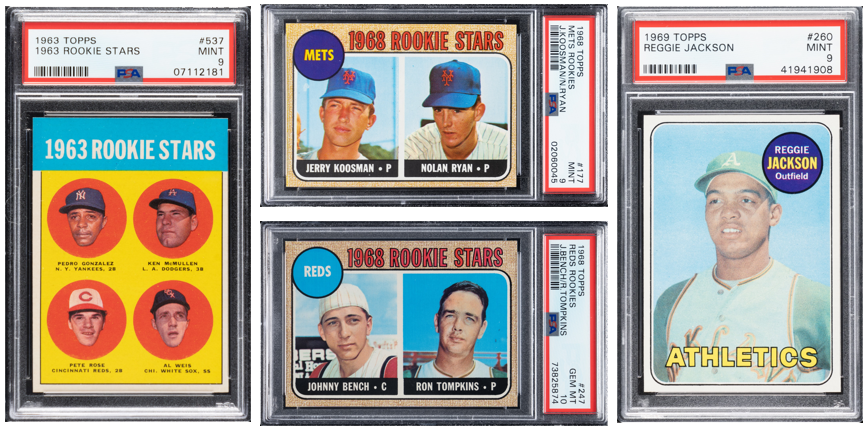
Overall, the caliber of stars making debuts in the1960s dropped off from the previous decade. However, despite not being rookie cards, stars like Mantle, Mays, Aaron and Clemente still had 1960s cards that are still valuable at high grades and are often found in our auctions.
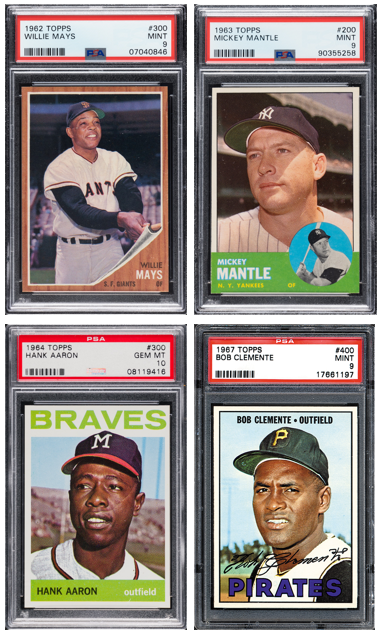
Card production and distribution continued to evolve to meet demand in the 1970s. Topps remained the market leader, producing sets with large card volumes, which included team-specific and other themed subsets along with the rookie and all-star cards. Rookies for George Brett, Robin Yount, Ozzie Smith and Mike Schmidt are among the most collectible. Since these cards are much less rare than their 1950s predecessors, only those in top condition can drive prices into four-figures.
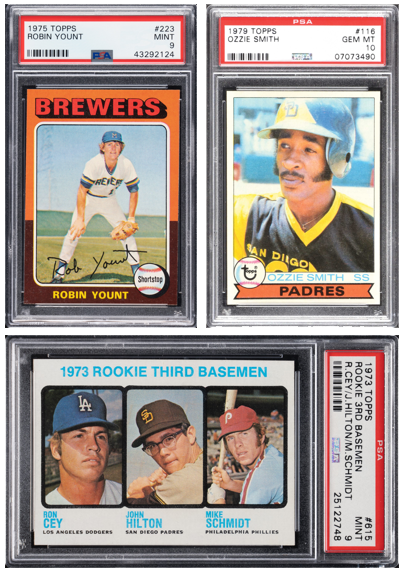
Perhaps the last true gem of the Topps exclusive reign was the 1980 Topps Rickey Henderson Rookie, which stands as one of the most valuable cards of the 1980s. In the early 1980s, the card bubble burst and the “junk wax era” began, where overproduction greatly reduced card values. As a result, highly-valued cards from the 1980s and 1990s are extremely scarce.

We’re Here For You
As with most eras, accurately assessing market value for post-war cards can be very challenging. If you have cards that may qualify for auction, give us a call at 301-608-0355 or complete the form to get in touch.